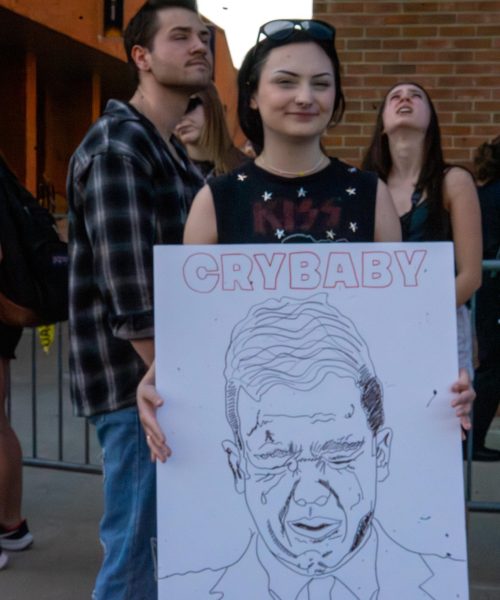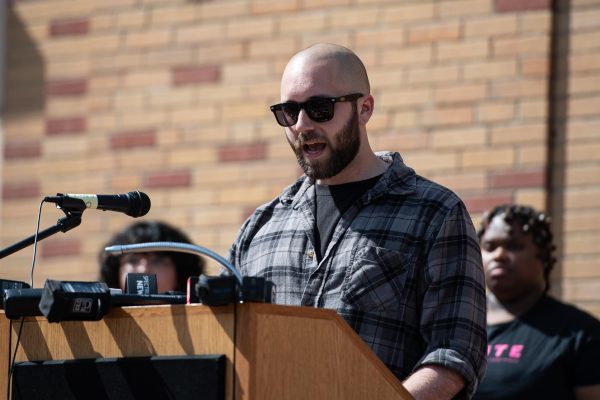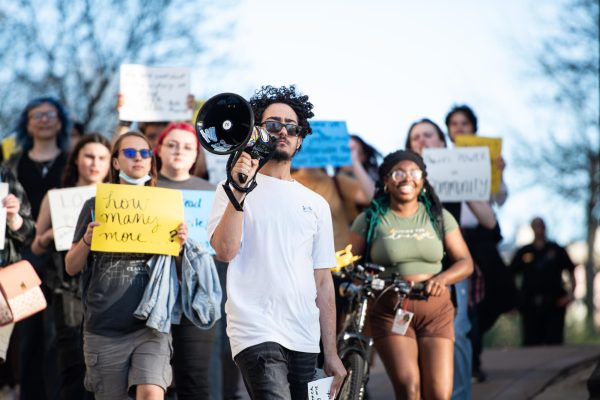After nearly 15 years at Kent State, Cartwright leaves a lasting impact
October 17, 2005
President Carol Cartwright made her mark in some way on everything the university has done in the nearly 15 years she has served as Kent State’s president.
From the creation of the Founders Scholars Program to the completion of the university’s first comprehensive fund-raising campaign in 2003, Cartwright led many of Kent State’s initiatives.
“It isn’t so much about the individual things she’s done,” said David Creamer, vice president for Administration. “It’s been the way she’s helped the institution to move forward and to put it in a position to continue to move forward when she retires. (Kent State is) an institution that is viewed so much more positively than it was when she arrived.”
There is a long list of what Cartwright and others say she accomplished. Here’s a partial list, starting with two accomplishments that haven’t received a great deal of notice in stories about her retirement.
Reaching out to regional campuses
Cartwright emphasized that the eight campuses of Kent State made up one university.
“When I arrived, I found what I considered to be a divide between what was then called the main campus and the branch campuses,” Cartwright said. “That worried me because we are one university, and there’s strength in thinking of ourselves as one university in many locations.”
She immediately began visiting the regional campuses, holding multi-campus events and dispelling the idea of branch campuses. The university also made the regional campuses stronger by offering more programs, marketing them more effectively and improving their facilities, said Garrison Walters, vice chancellor for academic affairs at the Board of Regents.
While the university is not where it needs to be with that effort, Cartwright said, they have made progress.
“Cultures get built up over decades and it takes a long time to change them,” she said.
Even last year, admissions advisers from different campuses were not communicating with one another, Cartwright said. Sometimes representatives from more than one would attend recruitment meetings at high schools. When the university discovered this, they fixed the problem.
The creation of the Division of Regional Development a little more than a year ago will also foster the community atmosphere. The division’s mission is to help Kent State campuses work with businesses and students to help the Northeast Ohio economy, said K. Marie David, director of Outreach Marketing.
The eight-campus setup was one of the main reasons she chose to come to Kent State, Cartwright said. She had worked at Pennsylvania State University, overseeing their multi-campus academics, and knew first hand how important that collaboration is.
Increasing diversity
When Cartwright arrived at Kent State, she said supporting diversity was one of her main goals. She said there has been progress.
“The progress is slow and steady, and I think that’s probably what you’d find at other institutions of our size and scale,” Cartwright said.
Even this fall, the book used for the first freshman reading project was related to diversity.
Cartwright said she places a strong focus on recruitment and retention of faculty, staff and students, with all kinds of characteristics. Diversity can include race, gender, sexuality, disability and cultural differences.
“Every one of us has certain characteristics that contribute to the mosaic of Kent State,” she said.
Improving enrollment
Despite a rise in admission requirements from a minimum high school grade point average from 2.2 to 2.5, enrollment rose for much of Cartwright’s tenure, said Chuck Rickard, associate vice president for Enrollment Services. It peaked at 24,347 last year after eight years of increase. It fell back slightly to 23,622 this fall.
“We became a first-choice institution for more students than ever before,” he said.
Cartwright had three major impacts on recruitment and enrollment, Rickard said. On a basic level, she kept academic programs updated and attractive to incoming students’ needs and wants.
She also went out of her way to make students feel welcome by attending regional receptions in Ohio and neighboring states and speaking to potential students and their parents, he said. Parents were impressed that the president of such a large university would fit talking to them into her agenda.
“Dr. Cartwright, given her schedule, always found time to attend these receptions,” Rickard said.
Another way she helped increase enrollment, Rickard said, was to support the university’s scholarship efforts, especially the Founders and Trustees scholars. “This enabled us to increase the number of highly-talented students we were trying to attract to Kent State,” he said.
Cartwright began the Founders Scholars Program, announcing her plan to launch a major scholarship program during her inaugural address, said Gail Beveridge, director of Donor Relations and Special Events.
Cartwright and her husband funded the first scholarship. Over the past 14 years, the program has grown to a more than $12 million program, serving about 200 students each year.
Raising funds
Cartwright also led the university’s first major fund-raising campaign, which raised more than $120 million.
“We basically had a horrible endowment and no previous presidents paid attention to that,” said emeritus political science professor Tom Hensley, who has been at Kent State for 37 years.
Cartwright has said she plans to help with the university’s second drive, which is now in a “quiet” phase while it lays the groundwork for the public launch.
Cartwright has dealt with declining state funding since the first day of her presidency, when the governor announced a budget cut.
Renovating campus
Cartwright has presided over the renovation of many Front Campus buildings, including Moulton, Lowry, Merrill and McGilvrey halls and the University Auditorium. Franklin Hall is in the first states of renovation. Creamer said much of the renovation was internal, bringing the buildings up-to-date technology.
Cartwright led the building of the Student Recreation and Wellness Center and saw the construction of the Liquid Crystal Material Sciences Building.
Under her tenure, the university began a master plan to upgrade residence halls, starting with the building of Centennial Court.
Restructuring academics
Cartwright saw significant changes to the academic structure of the university, as well. Kent State formed many interdisciplinary centers and institutes to expand research with companies outside the university, such as the Consortium for Biopreparedness and collaborations with the Summa Health System, she said.
Within the university, Kent State combined some areas, such as foreign languages, to make them stronger and more inclusive, Cartwright said. Many other areas experienced downsizing.
“We changed the basic structure so there were smaller, more focused colleges, so there’s a greater opportunity for visibility and identity,” she said. The College of Communications and Information is a good example, Cartwright said. The college was created from three programs in Fine and Professional Arts, Library and Information Sciences, Journalism and Mass Communications and Communication Studies and the graphic design program from the School of Arts. This offers opportunities to work inside a college but across schools.
Healing old wounds
When Cartwright was recruited, the university had just dedicated the May 4 Memorial, and there was a general feeling of the healing being done, Cartwright said.
“I realized, on my first day, the healing was certainly not over,” she said.
Cartwright said she began watching and studying to see what the university needed to move forward. She participated in the candlelight vigil her first year and every one since.
She said it was time to accept the shootings as part of the university’s history. Cartwright wanted that to also include a way to examine democracy through academics.
The first Symposium on Democracy was held in 2000 on the 30th anniversary of the shootings. The symposium creates a learning forum to explore issues related to American democracy from a perspective of the May 4 shootings, said Hensley, who was the chair of the first committee.
“No one was talking about the opportunity to educate people,” Cartwright said. “We’re very quick to talk about rights and privileges, but we’re not as comfortable talking about the responsibility of living in a democracy.”
Controversies have “virtually disappeared” during the past 15 years, Hensley said.
Moving forward
Michael Schwartz, president of Cleveland State and former president of Kent State, said he thought Cartwright did a great job running the university. He also served as a faculty member after retiring as president. Schwartz said Cartwright did all he could have hoped for the university.
“You start from the place you land and keep moving forward,” he said. “She’s done a great job of keeping the university on track in really hard financial times.”
Contact administration reporter Rachel Abbey at [email protected].























